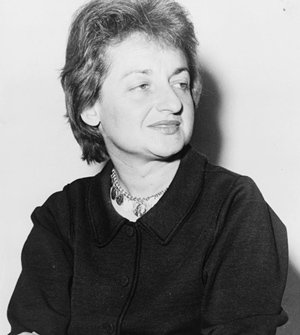
Betty Friedan was born on this date in 1921, and died on the same date in 2006 at the age of 85. Best known for her seminal 1963 book The Feminine Mystique, she became a leader of the American and global women’s movement, credited with sparking the second wave of American feminism. In 1966, Friedan founded and was elected the first president of the National Organization for Women (NOW), which aimed to bring women “into the mainstream of American society now [in] fully equal partnership with men.”
Born Bettye Naomi Goldstein in Peoria, Ill., to Jewish parents, she saw how fulfilling it was for her mother once she started writing a society column for the local newspaper. She attended Smith College, and in 1941, became editor-in-chief of the college newspaper. The editorials became more political under her leadership, taking a strong antiwar stance consistent with the position of the communist left at the time. After earning her degree in 1942 with a major in psychology, she headed west and became politically more active.
After a year at the University of California, Berkeley, Friedan became a journalist for leftist and labor union publications such as The Federated Press and the United Electrical Workers’ UE News. One of her assignments was to report on HUAC, the House Un-American Activities Committee.
Friedan was of the generation that witnessed both the influx of women into the wartime labor market, and the subsequent push to drive them back into their kitchens after the war. “The Feminine Mystique” is a critique of the anomie and loss of self-worth among those millions of women socialized to believe that their highest calling was wife, homemaker and mother. She lamented the tremendous loss of women’s skills, talents and labor resulting from this ideology.
Many of those millions of women returned to the labor force inspired by Friedan’s assurances that their lives could be more meaningful out in the wider world. But that movement began at a time of high union density, good wages and secure pensions. Within less than a generation, a single male worker’s wage no longer sufficed to keep a family thriving: Now, with the decimation of unions in the manufacturing sector, a two-income family became the norm just to stay in place economically, as wealth shifted from the broad middle class upward toward the One Percent.
Photo: Wikipedia (CC)












Comments